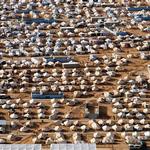SuperCamp – the Middle East as a regional zone of containment
The Middle East is hosting a large and steadily increasing number of refugees. How did the entire region turn into a SuperCamp?
This is one of the core questions for Are John Knudsen, senior researcher at CMI, and a multi-disciplinary team of researchers in the new FRIPRO-funded project SuperCamp: Genealogies of humanitarian containment in the Middle East. The effort to analyse the history and development of the Middle East as refugee region, is one of 14 researcher-projects awarded funding in 2019 (the Norwegian Research Council’s FRIPRO call received 246 applications).
-We argue that host countries in the Middle East form a regional containment zone; a SuperCamp under humanitarian governance where international actors like the UNHCR, UNRWA and host states provide the basic services that are needed to keep the refugees inside the region and outside continental Europe, says Knudsen.
The formation of a SuperCamp as an analytical concept is significant. The novelty of this project, in addition to the analytical approach, is the combination of specialized research fields that seldom communicate (refugee, migration and humanitarian border studies and history). The researchers will study the development of refugee policies in the Middle East from a long-term perspective, exploring three historical periods. The first is the period from 1850-1950 that started with the Armenian refugee crises and lay the basis for the modern humanitarian response to displacement. During the second period, from 1950-2000, the camp policy was created as a response to the Palestinian refugee crisis, but extended to other crises as well. The years from 2000 onwards has seen the ideas of containment which is so central to refugee camps, been taken even further.
-As a way of restricting refugees’ freedom of movement, we have started building fences and militarizing borders, says Knudsen.
The policy of turning back would-be migrants points towards a willed policy of containing refugees and migrants, instituted through a policy of regional containment and strengthened security at the borders by the EU and Schengen member states.
-This project is an attempt to develop a historical anthropology of the way the refugee displacement has been dealt with in the Middle East over longer time scales. In order to understand present day “refugee crises”, a new synthesis is needed.
- We aim to build a new understanding of the regional and, indeed, global forces of humanitarian containment, captured in the term SuperCamp, says Knudsen.
Project
